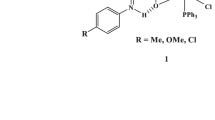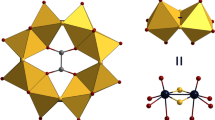Abstract
The crystal and molecular structure of 2-hydrazinobenzoic acid was determined. In solution in the presence of copper(II) chloride, 2-hydrazinobenzoic acid is transformed into 2-chlorobenzoic acid (HL1) and is coordinated to copper(II) cations to form the binuclear structure [Cu(H2O)]2(µ-L1)4 with bridging carboxylate groups of the ligand (L1)–. Three complexes of HL1 with Fe(II), Co(II), and Zn(II) were isolated in the crystalline state and studied by spectroscopic methods. It was found that the organic molecules are involved in the complexes in the monodeprotonated chelating form.




Similar content being viewed by others
REFERENCES
A. Eshwika, B. Coyle, and M. Devereux, BioMetals 17, 415 (2004).
M. Geraghty, V. Sheridan, M. McCann, et al., Polyhedron 18, 2931 (1999).
M. B. Chenoweth, Pharmocol. Rev. 8, 57 (1956).
J. Reid, R. D. Watson, J. B. Cochran, and D. H. Sproull, Br. Med. J. 1, 321 (1951).
J. R. J. Sorenson, J. Med. Chem. 27, 1747 (1984).
J. R. J. Sorenson, Metal Ions in Biological Systems, Vol. 14, Ed. by H. Siegel (Marcel-Dekker, New York, 1982), p. 77.
A. Čongrádyová and K. Jomová, J. Microbiol. Biotechnol Food Sci. 2 (Suppl. 1), 1377 (2013).
Z. Korolkiewicz, E. Hac, I. Gagalo, et al., Agents Actions 26, 355 (1989).
B.-H. Ye, M.-L. Tong, and X. M. Chen, Coord. Chem. Rev. 249, 545 (2005).
M. Eddaoudi, D. B. Moler, H. Li, et al., Acc. Chem. Res. 34, 319 (2001).
Y. Rodrıguez-Martın, M. Hernandez-Molina, and F. S. Delgado, Cryst. Eng. Commun. 4, 522 (2002).
G. M. Sheldrick, SHELX-86. Program for the Crystal Structure Determination (Univ. of Cambridge, Cambridge, England, 1986).
G. M. Sheldrick, Acta Crystallogr. A 64, 112 (2008).
G. M. Sheldrick, SHELXTL. Version 6.14. Structure Determination Software Suite (Brucker AXS, Madison, WI, USA, 2000).
M. Beck and I. Nad’pal, The Investigation of Complex Formation by New Methods (Mir, Moscow, 1989) [in Russian].
A. Albert and E. P. Serjeant, Ionization Constants of Acids and Bases (Wiley, New York, 1962).
K. Nakamoto, Infrared and Raman Spectra of Inorganic and Coordination Compounds (Wiley, New York, 1986).
T. Kawata, S. Ohba, T. Tokii, et al., Acta Crystallogr. C 48, 1590 (1992).
Funding
The study was supported by the Peoples’ Friendship University (project no. 5-100).
Author information
Authors and Affiliations
Corresponding author
Additional information
Translated by T. Safonova
Rights and permissions
About this article
Cite this article
Alabada, R., Avramenko, O.V., Strashnova, S.B. et al. Unusual Substitution in Hydrazinobenzoic Acid upon Complexation. Crystal and Molecular Structure of Hydrazinobenzoic Acid Hydrochloride. Crystallogr. Rep. 66, 429–432 (2021). https://doi.org/10.1134/S1063774521030032
Received:
Revised:
Accepted:
Published:
Issue Date:
DOI: https://doi.org/10.1134/S1063774521030032




